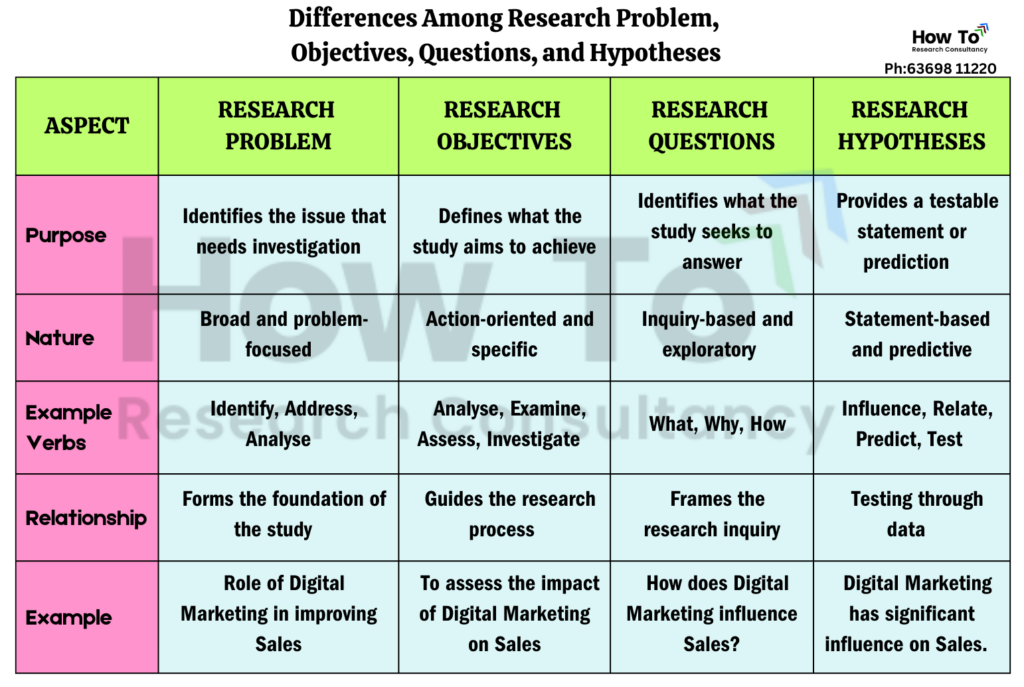Introduction
Framing research objectives is a crucial step in conducting a study, as they provide clear direction and focus. Well-defined objectives help researchers stay on track, guide data collection, and ensure the study meets its intended goals. In this blog, we explore how to frame research objectives effectively, along with practical examples.
What are Research Objectives?
Research objectives are specific, measurable goals that define what a study aims to achieve. They help break down the broader research problem into smaller, manageable tasks. Research objectives should be:
- Specific: Clearly state what the research intends to investigate.
- Measurable: Define parameters to assess the achievement of objectives.
- Achievable: Ensure the objectives are realistic given the available resources.
- Relevant: Align objectives with the research problem and field of study.
- Time-bound: Set a timeframe for achieving the objectives.
Steps to Frame Research Objectives
1. Define the Research Problem
Before setting objectives, clearly define the research problem. A well-stated problem provides the foundation for developing meaningful objectives.
Example: If the research problem is “What factors influence Electric Vehicle adoption in Chennai?”, the objectives will focus on exploring and analysing these factors.
2. Use Action-Oriented Verbs
Start each objective with action-oriented verbs like analyse, examine, investigate, compare, assess, and determine to ensure clarity.
Example: Instead of writing, “To study consumer preferences,” write, “To analyse the key factors influencing consumer preferences for Electric Vehicles.”
3. Break Down the Research Scope
Dividing the broader study into focused objectives ensures clarity and depth in analysis. If specific statistical analyses, such as mediation or moderation analysis through AMOS/SPSS, etc. are planned, a dedicated objective should be framed for that.
Example:
- To assess the mediating role of consumer trust between environmental awareness and purchase intention.
- To examine the moderating effect of financial incentives on consumer adoption of electric vehicles.
Additionally, objectives can also be framed based on key study variables such as Customer Perception, Satisfaction, and Loyalty, ensuring a comprehensive examination of each aspect separately.
4. Align with the Research Hypothesis or Questions
Once objectives are framed, make sure they should align with research hypotheses (if applicable) or research questions. This ensures consistency in the study and prevents misalignment between the different components of the research framework.
Example Research Questions:
- What factors influence consumer perception of Electric Vehicles?
- How do cost and incentives affect adoption decisions for Electric Vehicles?
- Does environmental awareness impact the willingness to purchase an Electric Vehicles?
Example Hypotheses:
- H1: Higher levels of environmental awareness positively influence the adoption of Electric Vehicles.
- H2: Financial incentives have a significant impact on purchase decisions of Electric Vehicles.
5. Prioritize Primary and Secondary Objectives
Distinguishing between primary and secondary objectives helps in structuring research focus.
- Primary objectives address the core aim of the study.
- Secondary objectives explore additional aspects that support the main research goals.
Example:
- Primary Objective: To assess the impact of environmental awareness on electric vehicle adoption.
- Secondary Objective: To analyse consumer trust as a mediating factor in the adoption process of Electric Vehicles.
6. Ensure Feasibility and Practicality
Make sure the objectives can be achieved within the given timeframe, budget, and resources.
Example: If data collection is limited to online surveys, setting an objective to conduct in-depth personal interviews might not be feasible.
Logical order of Research Elements
In research, the process follows a logical sequence. It starts with identifying the Research Problem, which highlights the main issue or gap that needs to be studied. Once this problem is clear, Research Objectives are set to define what the study aims to achieve. These objectives help in forming Research Questions, which focus on specific aspects of the problem. Finally, if needed, Research Hypotheses are developed based on these questions. Hypotheses are testable predictions that can be examined using data collection and statistical analysis.
Differences Among Research Problem, Objectives, Questions, and Hypotheses
The table below highlights the correct order and key differences among research problem, objectives, questions, and hypotheses:

Common Mistakes to Avoid
- Being Too Vague: Avoid broad objectives like “To study customer behaviour.” Instead, specify the aspect (Perception or Satisfaction, Post-purchase Behaviour, etc.) being studied.
- Lack of Measurability: Objectives should be structured to allow assessment through analysis. For example, “To compare customer satisfaction levels across different banking services” is a measurable objective. However, an objective like “To provide suggestions and recommendations based on the results” is not ideal, as it does not define a specific analytical measurement. Additionally, offering suggestions and recommendations is a natural outcome of most studies and does not require a separate objective.
- Too Many Objectives: Keep objectives focused; too many can dilute the study’s impact. Generally, 4 to 6 objectives are sufficient for PhD Research.
- Overlapping Objectives: Ensure each objective is distinct and does not repeat the same idea in different words.
- Ignoring Practical Constraints: Consider time, budget, and data availability when framing objectives.
- Misalignment with Research Questions: Ensure objectives directly relate to and support the study’s research questions.
- Using Unclear Terminology: Avoid jargon or ambiguous terms that may lead to misinterpretation.
Conclusion
Well-framed research objectives provide clarity and structure, ensuring a study is focused and effective. By following these steps and using practical examples, researchers can develop objectives that guide their work efficiently and contribute to meaningful findings.
Start framing your research objectives today using these guidelines! Share your thoughts or challenges in the comments, and let’s discuss how to refine them further.









Leave a Reply